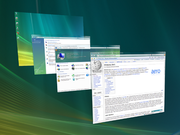Visual styles
Windows Vista has four distinct visual styles.[30]
- Windows Aero
- Windows Vista's premier visual style is built on a new desktop composition engine called Desktop Window Manager. Windows Aero introduces support for 3D graphics (Windows Flip 3D), translucency effects (Glass), live thumbnails, window animations, and other visual effects, and is intended for mainstream and high-end graphics cards. To enable these features, the contents of every open window is stored in video memory to facilitate tearing-free movement of windows. As such, Windows Aero has significantly higher hardware requirements than its predecessors. 128 MB of graphics memory is the minimum requirement, depending on resolution used.[31] Windows Aero (including Windows Flip 3D) is not included in the Starter and Home Basic editions.
- Windows Vista Standard
- This mode is a variation of Windows Aero without the glass effects, window animations, and other advanced graphical effects such as Windows Flip 3D. Like Windows Aero, it uses the Desktop Window Manager, and has generally the same video hardware requirements as Windows Aero. This is the default mode for the Windows Vista Home Basic Edition. The Starter Edition does not support this mode.
- Windows Vista Basic
- This mode has aspects that are similar to Windows XP's visual style with the addition of subtle animations such as those found on progress bars. It does not employ the Desktop Window Manager; as such, it does not feature transparency or translucency, window animation, Windows Flip 3D or any of the functions provided by the DWM. The Basic mode does not require the new Windows Display Driver Model (WDDM) for display drivers, and has similar graphics card requirements to Windows XP. For computers with graphics cards that are not powerful enough to support Windows Aero, this is the default graphics mode.
- Windows Classic
- An option for corporate deployments and upgrades, Windows Classic has the look and feel of Windows 2000 and Windows Server 2003, does not use the Desktop Window Manager, and does not require a WDDM driver. As with prior versions of Windows, this visual style supports "color schemes," which are a collection of color settings. Windows Vista includes six classic color schemes, comprised of four high-contrast color schemes and the default color schemes from Windows 98 and Windows 2000.
 |  |  |
Hardware requirements
Computers capable of running Windows Vista are classified as Vista Capable and Vista Premium Ready.[32] A Vista Capable or equivalent PC will be capable of running all editions of Windows Vista although some of the special features and high end graphics options may require additional or more advanced hardware. A Vista Premium Ready PC will take advantage of Vista's "high-end" features.[33]
Windows Vista's "Basic" and "Classic" interfaces will work with virtually any graphics hardware that supports Windows XP or 2000; accordingly, most discussion around Vista's graphics requirements centers on those for the Windows Aero interface. As of Windows Vista Beta 2, the NVIDIA GeForce FX 5200 and later, the ATI Radeon 9500 and later, Intel's GMA 950 integrated graphics, and a handful of VIA chipsets and S3 Graphics discrete chips are supported.[34] Microsoft offers a tool called the Windows Vista Upgrade Advisor[35] to assist XP and Vista users in determining what versions of Windows their machine is capable of running.
| Vista Capable[31] | Vista Premium Ready[31] | |||||||||||||||||
|---|---|---|---|---|---|---|---|---|---|---|---|---|---|---|---|---|---|---|
| Processor | 800 MHz | 1.0 GHz | ||||||||||||||||
| Memory | 512 MB RAM | 1 GB RAM | ||||||||||||||||
| Graphics card | DirectX 9 capable | DirectX 9 capable GPU with Hardware Pixel Shader v2.0 and WDDM 1.0 driver support | ||||||||||||||||
| Graphics memory | N/A | 128 MB RAM supports up to 2,756,000 total pixels (e.g. 1920 × 1200) or 512 MB+ for greater resolutions such as 2560x1600[36] | ||||||||||||||||
| HDD capacity | 20 GB | 40 GB | ||||||||||||||||
| HDD free space | 15 GB | 15 GB | ||||||||||||||||
| Other drives | DVD-ROM | DVD-ROMExternal links
Microsoft
Reviews and screenshots
| ||||||||||||||||


No comments:
Post a Comment